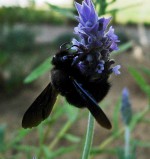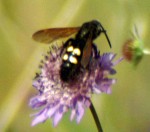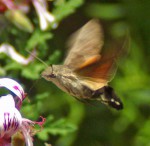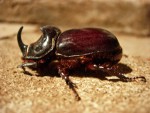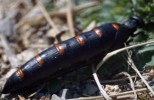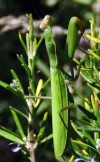Location of the park
There are presently 24 parques nacionales in Andalucía that have special protection as “locations of great ecological, scientific and educational value and having ecosystems that have been little altered by man”. The area designated as El Parque de los Alcornocales – The Park of the Cork Oak Forests- was granted its status in 1989 and is the most southerly of mainland Spain’s protected natural areas, laying claim to some 170,000 hectares of western Andalucía. Its range extends from El Bosque at the northern end, reaching down to the Straits of Gibraltar in the south between Punta del Canero (Algeciras) and Tarifa. Most of the park lies within Cadíz Province, extending into Malaga Province at its north-eastern end and creates a green corridor from the Sierra de Grazalema natural park through to the coastal zone at Tarifa.

Southern end of the park at Punto de Canero, Straits of Gibraltar.The N African coastline is on the horizon across the Straits
Character and climate
The character and climate of the park are influenced by its proximity to both the Mediterranean Sea and the Atlantic Ocean and the orientation of the sierras within it from north to south. Five sierras form the continuous sandstone backbone of the Spanish side of the Straits of Gibraltar; these are Ojen (810m) and Luna (786m), el Cabrito (536m) which faces to the south-west, el Bujeo (657m) facing south and Algarrobo (679m) facing south-east.

View from el Bujeo, at the southern end of the parrk – across Algeciras to Gibraltar & beyond to the N African coastline
Despite its southerly location the area receives a surprisingly high rainfall, that can vary, according to altitude between 70cm and 200cm per year and is brought about mainly by the prevailing westerly winds. High levels of humidity are also maintained during the spring and summer months as a result of the Levante wind. This wind blows hard across the Mediterranean from North Africa, picking up moisture as it passes over the sea. As the wind encounters a landmass, the moisture is discharged in the form of thick morning mists that evelop the mountains. On the mountain peaks the mist persists and causes the appearance of stationary clouds that are known locally as ‘Barbas de Levante’, Levante Beards. In the summer months hot sun quickly burns off the mists, but during the spring lower temperatures and cloud cover can cause them to hang around which can bring about a surprisingly cool start to the mornings. The western flanks of the mountains face the Atlantic Ocean and gather rain clouds about them during the winter months. The resultant rainfall is high and the mountains and valleys are bisected with numerous fast-flowing streams. From here the rivers Miel and Picaro flow to the Bay of Gibraltar/ Algeciras.
Flora
The warm, humid climate has nurtured an abundant and diverse flora within some of Andalucía’s most extensive stretches of forest, the most notable being the vast tract of Cork Oak forest for which the Park is named and that is considered to be amongst the largest on the planet. Most of the land is privately owned and harvests are still taken regularly, the main crop being cork bark, which is stripped from oak trees of the species, Quercus suber.This forest, the densest of its type in Iberia, plays an important part in the world market of cork based products.
There are some regional variations in the flora of the sierras, but throughout a huge variety of plants grow in these mountains. The dominant trees throughout are Cork Oaks with smaller numbers of Algerian Oaks; Alder buckthorn grows close to mountain streams and there are stands of Maritime and Monterrey Pines. Around El Bujeo, Rhododendrons, Foxgloves and the fascinating carnivorous Drosophilum lusitanicum are found thriving in the acid soil characteristic of sandstone.
There are over 40 species of fern in the area, they can be found tucked into damp rocks and draped from rough bark of the huge oaks. One is the rare fern psilotum nudum along with Hare’s foot fern (Davallia canariensis), Hard fern (Blechnum spicant) and two species from the Canary Islands, which are Pteris incompleta and Culcita macrocarpa.
Fauna:
As much of the land remains privately owned, most of the fauna encountered when out walking in the park is domesticated. Some areas have been cleared of trees to create pastures for cattle, but in many places cows wander at will along woodland tracks grazing on any edible vegetation, usually announcing their presence with the bells placed around their necks and may pause in their feeding to watch you pass by. Their dung is eagerly sought by dung beetles. The mixed oak species provide food for the local pig raising industry; their diet of acorns gives the meat a rich flavour. Cerdo Iberico is a famed Iberian breed of black pig which looks quite similar to a wild boar. The gastronomy of the area makes use of available aromatic herbs, honey, fungus and snails as well as hunted game, including Red-legged Partridge and Roe deer, Red deer and Fallow deer have been introduced as game for hunting as well as Spanish ibex on the higher terrain. Wild mammals living within the forest include Wild boar, Mongoose, Fox, Badger, Genet, and Dormouse. In the rivers are Terrapins and Otters.
Of the twenty two species of bats listed in Andalucia, twenty are recorded in the park.
The birdlife within Los Alcornocales is exceptional, abundant and varied and the park is regarded as one of the best areas in the whole of Europe for ornithology. This is due in part to the great diversity of habitats, but also because of the seasonal migrations to and from the African continent that bring literally millions of birds over the park. A wide variety of woodland birds are resident here and their numbers are regularly boosted by migrant birds during the winter months. Kingfishers, Dippers and Sand martins may be seen near the water courses.In the spring there is an influx of birds returning from Africa to breed here, including Golden oriole, Hoopoe, Bonelli’s warbler, Bee-eater and Nightingale.
Among the raptors found throughout the park’s range are Short-toed, Bonelli’s, Spanish Imperial, and Booted eagles, Black-winged Kite, Sparrow hawk, Goshawk, Peregrine, Kestrel, Tawny owl, Eagle owl and Common buzzard. Egyptian and Griffon vultures can be seen in more open areas. During spring and autumn migrating birds pass through or rest in the forest which is close to the Straits of Gibraltar.









